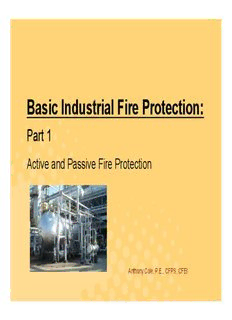
Industrial Fire Protection PART 1 - ARC Fire Engineering PDF
Preview Industrial Fire Protection PART 1 - ARC Fire Engineering
Basic Industrial Fire Protection: Part 1 Active and Passive Fire Protection Anthony Cole, P.E., CFPS, CFEI Basic and Advance Industrial Fire Protection Course • Basic Industrial Fire Protection (IFP) § Prescriptive-based on various API Documents § Active and passive fire protection § Management of hazards and risk • Advance Industrial Fire Protection (IFP) § Performance-based using the Thomas Barry’s book and other various AICHE/CCPS references § Involves the aid of computer modeling Course Outline: Basic IFP • Part 1: Active and Passive Fire Protection § API RP 2001, “Fire Protection In Refineries” § API 2021, “Management of Atmospheric Storage Tanks” § API 2510A, Fire Protection considerations for the Design and Operation of Liquefied Petroleum Gas (LPG) Storage Facilities” § API 2030, “Application of Fixed Water Spray Systems for Fire Protection in the Petroleum Industry” § API 2218, “Fireproofing Practices in the Petroleum and Petrochemical Processing Plants” Course Outline: Basic IFP • Part 2: Advance Hazard Control § API 521, “Pressure-relieving and Depressuring Systems” § API 2028, “Flame Arresters in Piping Systems” § API 2210, “Flame Arresters for Vents of Tanks Storing Petroleum Products” § API 750, “Management of Process Hazards” § API 752, “Management of Hazards Associated with Location of Process Plant Buildings” Course Outline: Basic IFP • Part 3: Managing Risk § API 760, “Model Risk Management Plan Guidance for Petroleum Refineries” § AICHE/CCPS, “Guidelines for Hazard Evaluation Procedures” § AICHE/CCPS, “Guidelines for Chemical Process Quantitative Risk Analysis” Course Outline: Advance IFP • Part 1: § Industrial Application of Computer Modeling Programs Wind direction TANK Course Outline: Advance IFP • Part 2: § Risk-Informed, Performance-Based Industrial Fire Protection ’ Today s Objectives • Discuss the basic principles of active and passive fire protection • Introduce/review the five (5) “core” API Standards • Application of the API Standards to real life situations • Question and answers • Conclusion Active and Passive Fire Protection • What is active fire protection? A fire protection method that employs manual or automated means of activation, initiation, alerting, or opening by use of mechanical or electrical devices to deliver, remove, isolate, or otherwise detect and/or suppress a hazard. Active and Passive Fire Protection • Examples include: § Sprinkler systems § Clean agent gas systems § Fire detection systems § Smoke control and management systems § Portable Equipment (fire extinguishers/hose cabinets)
Description: